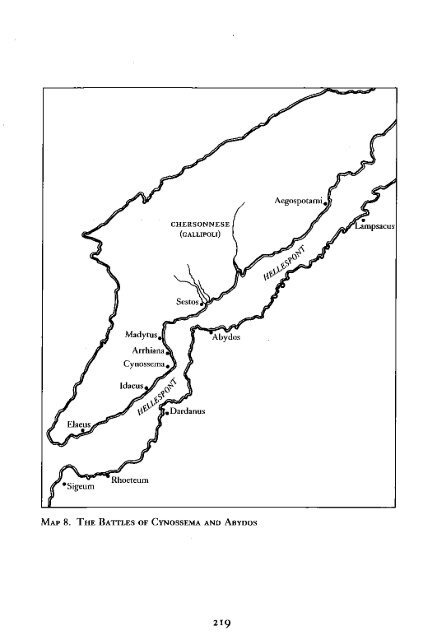The Fall of the Athenian Empire-(A New History of the Peloponnesian War) Donald Kagan - (1987)
MACEDONIA is GREECE and will always be GREECE- (if they are desperate to steal a name, Monkeydonkeys suits them just fine) ΚΑΤΩ Η ΣΥΓΚΥΒΕΡΝΗΣΗ ΤΩΝ ΠΡΟΔΟΤΩΝ!!! Strabo – “Geography” “There remain of Europe, first, Macedonia and the parts of Thrace that are contiguous to it and extend as far as Byzantium; secondly, Greece; and thirdly, the islands that are close by. Macedonia, of course, is a part of Greece, yet now, since I am following the nature and shape of the places geographically, I have decided to classify it apart from the rest of Greece and to join it with that part of Thrace which borders on it and extends as far as the mouth of the Euxine and the Propontis. Then, a little further on, Strabo mentions Cypsela and the Hebrus River, and also describes a sort of parallelogram in which the whole of Macedonia lies.” (Strab. 7.fragments.9) ΚΚΕ, ΚΝΕ, ΟΝΝΕΔ, ΑΓΟΡΑ,ΕΚΚΛΗΣΙΑ,ΝΕΑ,ΦΩΝΗ,ΦΕΚ,ΝΟΜΟΣ,LIFO,MACEDONIA, ALEXANDER, GREECE,IKEA
MACEDONIA is GREECE and will always be GREECE- (if they are desperate to steal a name, Monkeydonkeys suits them just fine)
ΚΑΤΩ Η ΣΥΓΚΥΒΕΡΝΗΣΗ ΤΩΝ ΠΡΟΔΟΤΩΝ!!!
Strabo – “Geography”
“There remain of Europe, first, Macedonia and the parts of Thrace that are contiguous to it and extend as far as Byzantium; secondly, Greece; and thirdly, the islands that are close by. Macedonia, of course, is a part of Greece, yet now, since I am following the nature and shape of the places geographically, I have decided to classify it apart from the rest of Greece and to join it with that part of Thrace which borders on it and extends as far as the mouth of the Euxine and the Propontis. Then, a little further on, Strabo mentions Cypsela and the Hebrus River, and also describes a sort of parallelogram in which the whole of Macedonia lies.”
(Strab. 7.fragments.9)
ΚΚΕ, ΚΝΕ, ΟΝΝΕΔ, ΑΓΟΡΑ,ΕΚΚΛΗΣΙΑ,ΝΕΑ,ΦΩΝΗ,ΦΕΚ,ΝΟΜΟΣ,LIFO,MACEDONIA, ALEXANDER, GREECE,IKEA
Create successful ePaper yourself
Turn your PDF publications into a flip-book with our unique Google optimized e-Paper software.
THE WAR IN THE HELLESPONT 221<br />
use this very favorable opportttnity to destroy <strong>the</strong> A<strong>the</strong>nian fleet entirely.'•<br />
<strong>The</strong> center should have little trouble carrying out its part <strong>of</strong><br />
<strong>the</strong> strategy; if it succeeded, <strong>the</strong> resulting weakness in <strong>the</strong> A<strong>the</strong>nian<br />
center might lure <strong>the</strong> right to hurry to its aid, <strong>the</strong>reby allowing Mindarus<br />
to cut <strong>the</strong>m <strong>of</strong>f. Should that occur, it would be relatively easy<br />
to catch <strong>the</strong> A<strong>the</strong>nian right between <strong>the</strong> victorious <strong>Peloponnesian</strong> center<br />
and <strong>the</strong> ships <strong>of</strong> Mindarus. After that it would not be difficult to<br />
destroy <strong>the</strong> isolated A<strong>the</strong>nian left at leisure.<br />
Thrasybulus placed Thrasyllus at <strong>the</strong> head <strong>of</strong> <strong>the</strong> column, on <strong>the</strong><br />
left wing opposite <strong>the</strong> Syracusans. He himself commanded <strong>the</strong> right,<br />
opposite Mindarus."' We cannot be confident <strong>of</strong> what strategy he may<br />
have planned in advance. Since <strong>the</strong> initiative lay with <strong>the</strong> enemy, he<br />
must be prepared to react swiftly to whatever occurred, but it was<br />
possible, at least, to try to anticipate Mindarus' strategy and to make<br />
contingent plans. Thrasybulus ei<strong>the</strong>r anticipated <strong>the</strong> strategy very<br />
well, or he reacted with a shrewd and sure instinct when he saw <strong>the</strong><br />
course <strong>of</strong> events!' Mindarus allowed <strong>the</strong> A<strong>the</strong>nian left under Thrasyllus<br />
to move beyond <strong>the</strong> narrows in front <strong>of</strong> <strong>the</strong> Cynossema promontory.<br />
When it had passed by, around <strong>the</strong> sharp bend that cut <strong>of</strong>f<br />
<strong>the</strong> sight <strong>of</strong> <strong>the</strong> rest <strong>of</strong> <strong>the</strong> A<strong>the</strong>nian fleet, and when <strong>the</strong> center had<br />
come to <strong>the</strong> narrowest part <strong>of</strong> <strong>the</strong> strait, <strong>the</strong> <strong>Peloponnesian</strong> center<br />
launched its attack with excellent results. <strong>The</strong> left under Thrasyllus<br />
had its hands full with <strong>the</strong> ships in its waters and, in any case, could<br />
not could not see what was happening to <strong>the</strong> center because <strong>of</strong> <strong>the</strong><br />
promontory that cut <strong>of</strong>f vision down <strong>the</strong> strait.<br />
<strong>The</strong> outcome <strong>of</strong> <strong>the</strong> battle hung on <strong>the</strong> action <strong>of</strong> <strong>the</strong> A<strong>the</strong>nian right<br />
under Thrasybulus. Had he tried to assist <strong>the</strong> center, he would have<br />
failed, because he would have been badly outnumbered by <strong>the</strong> combination<br />
<strong>of</strong> <strong>the</strong> enemy's center and left and would have been trapped<br />
between <strong>the</strong>m. His ships and <strong>the</strong> entire A<strong>the</strong>nian fleet would have<br />
been annihilated. Thrasybulus, however, did not fall into <strong>the</strong> trap.<br />
When he saw Mindarus moving toward <strong>the</strong> mouth <strong>of</strong> <strong>the</strong> strait to cut<br />
<strong>of</strong>f escape, he employed <strong>the</strong> greater speed <strong>of</strong> <strong>the</strong> A<strong>the</strong>nians to defeat<br />
J~or <strong>the</strong> most useful account <strong>of</strong> <strong>the</strong> battle, see Busolt, GG III:2, I5I7-1519.<br />
40<br />
Diodorus (IJ.J9·4) erroneously reverses <strong>the</strong> position <strong>of</strong> Thrasyllus and<br />
Thcasybulus.<br />
41<br />
Thucydides' language seems to me compatible with ei<strong>the</strong>r possibility. After describing<br />
<strong>the</strong> <strong>Peloponnesian</strong> intentions he says: ol. 'AOTJvaLoL -yv6vn:c; (8. 104.4). yv6vnc;<br />
could mean "knowing <strong>the</strong> enemy's intentions" or "perceiving what <strong>the</strong> enemy was<br />
doing."

















